Understand
Dating back to 974, Vitebsk has always been a vibrant center of culture and commerce, attracting various occupiers throughout its long history. Today, it remains a thriving hub of arts and culture in the Republic of Belarus. Surrounded by breathtaking countryside, this city offers a perfect blend of historical charm and natural beauty. Prepare to be captivated by its rich heritage and stunning landscapes.
Map & Climate
Popular Foods
 Draniki - Draniki are Belarusian potato pancakes made from grated potatoes, flour, eggs, and onions. They are pan-fried until crisp and golden brown, giving them a crunchy exterior and soft, fluffy interior. These savory pancakes are often served with sour cream or butter, accompanied by smoked meats, fish, or vegetables.
Draniki - Draniki are Belarusian potato pancakes made from grated potatoes, flour, eggs, and onions. They are pan-fried until crisp and golden brown, giving them a crunchy exterior and soft, fluffy interior. These savory pancakes are often served with sour cream or butter, accompanied by smoked meats, fish, or vegetables. Borsch – Borsch is a traditional Belarusian soup that primarily consists of beetroot as its main ingredient. It also includes potatoes, carrots, cabbage, onions, and various types of meat, such as beef or sausage, which can be omitted to make it a vegetarian dishes. The vibrant red soup is cooked with garlic, herbs, and spices, serving hot with a side of freshly baked bread or boiled dumplings called 'varenyky'.
Borsch – Borsch is a traditional Belarusian soup that primarily consists of beetroot as its main ingredient. It also includes potatoes, carrots, cabbage, onions, and various types of meat, such as beef or sausage, which can be omitted to make it a vegetarian dishes. The vibrant red soup is cooked with garlic, herbs, and spices, serving hot with a side of freshly baked bread or boiled dumplings called 'varenyky'. Kladoto – Kladoto is a type of Belarusian pelmeni, which are dumplings filled with seasoned meat (usually pork, beef, or a mixture) and onions. The dough is made from flour, water, salt, and oil, wrapped around the savory filling before being cooked in boiling water. They are commonly served hot, topped with sour cream or butter, and sometimes accompanied by a side of sauerkraut or pickled vegetables.
Kladoto – Kladoto is a type of Belarusian pelmeni, which are dumplings filled with seasoned meat (usually pork, beef, or a mixture) and onions. The dough is made from flour, water, salt, and oil, wrapped around the savory filling before being cooked in boiling water. They are commonly served hot, topped with sour cream or butter, and sometimes accompanied by a side of sauerkraut or pickled vegetables.




Comments
NO COMMENTS